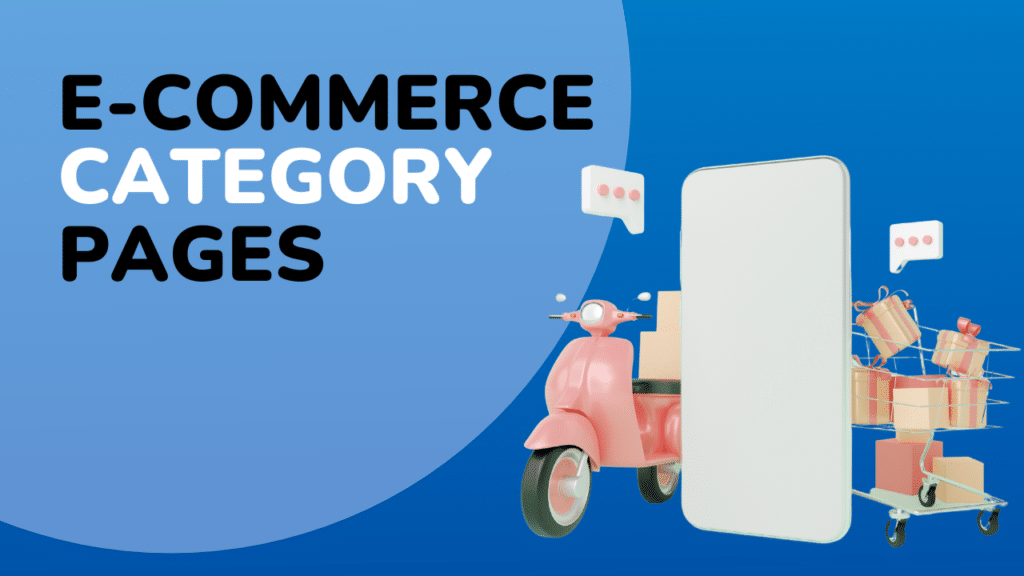Customer retention rate is one of the most important metrics of most businesses. Depending on the model of a business, it can be more important than gaining new customers.
Even if you have many new customers, while your customer retention rate is low, you will lose a lot of money. It doesn’t matter how much a customer spends if he leaves your business.
It costs about six times more to acquire new customers than to keep existing customers engaged with your brand and products.
If you focus on increasing your customer retention rate, your business will surely be successful.
So, how do you calculate and increase customer retention rates? Here are some tips for doing so:
What is the Customer Retention Rate?
The customer retention rate is the percentage of customers who keep buying from your company compared to those who stop buying.
The customer retention rate is a vital metric for any business because it tells you how well you’re doing at keeping your customers happy and coming back for more.
A high customer retention rate can help you:
- Increase revenue: Happy customers are more likely to buy more products and services from you, which will increase your revenue in the long run.
- Lower costs: The cost of acquiring new customers tends to be higher than retaining existing ones, so lowering churn can help you save money on marketing campaigns and other acquisition expenses.
- Reduce churn: If you’re losing customers because they don’t like what you’re selling or are not being properly supported, it’s essential to understand why so that you can reduce churn further down the line.
How To Calculate Your Customer Retention Rate
Calculating customer retention rate can be tricky, but it’s an essential metric for any business owner or executive.
The customer retention rate formula is your annual customer churn rate divided by your annual customer base.
The formula looks like this:
(1 – Annual Churn Rate) / (Annual Customer Base) = Customer Retention Rate
For example, if you have 1,000 customers at the end of the year and 100 of them leave during that period (an annual churn rate of 10%), then your customer retention rate would be 90%. This means that for every 100 new customers you acquire during the year, 90% of them remain with your company until they leave or cancel their service altogether.
One of the other metrics you can evaluate to track your customer retention rate is the customer lifetime value (CLV).
According to Nat Miletic, Owner & CEO of Clio Websites,
“CLV digs deeper into the client’s contribution to our sales throughout their business lifecycle. It provides valuable insights into which marketing campaigns work and which areas need our intervention to boost our client retention strategy through customer loyalty programs and other incentives that offer the most value.
A high CLV is an excellent indicator of a great customer retention rate. Because they contribute more to our business, we can also set our sights on lead generation and customer acquisition to complement our effective client retention strategy.”
How To Improve Your Customer Retention Rate
1. Improve Your Communication
You may be surprised to learn that 33% of customers consider a friendly and knowledgeable agent the most important aspect of good customer service.
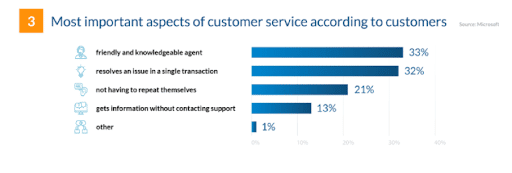
(Source)
Clearly, communication is key to keeping customers happy and increasing customer retention.
To start improving your communication with customers, you first need to understand what they want. Here are some ways you can improve your customer experience:
- Make sure your website is easy to use. If you have an online store, make sure it’s easy for customers to find what they’re looking for and check out quickly. If you have a brick-and-mortar store, ensure there’s enough staff available so that no one has to wait long in line.
- Respond ASAP when customers reach out via email or social media channels. Make sure you respond within 24 hours — preferably within an hour! This shows that you care about their needs and want to help as soon as possible. And don’t forget to address negative feedback as well.
- Ensure your employees know how important customer satisfaction is so they can treat every customer like royalty!
RELATED ARTICLE: How To Calculate Conversion Rate For Your Website
Most importantly, use multiple methods of communication, such as email and live chat, so that you can reach out to customers at any time. And if you look at the statistics, 62% of customers use email to communicate with brands, while – 47% use live chat.
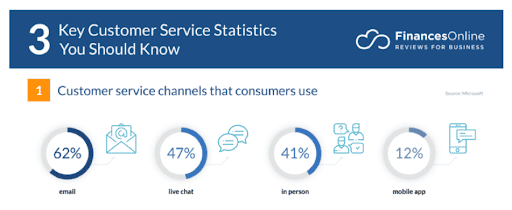
(Source)
Other stats point out that 54% of global customers favor brands that respond to their customer service queries on social media.
A good example of a brand using Live Chat is Tymo Beauty, an e-commerce business.
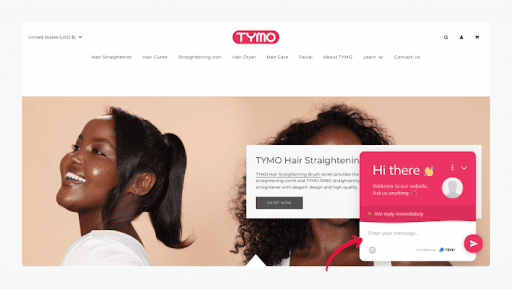
(Source)
The company put its lead generation on autopilot with the help of live chat to gather prospects for them. It made it easier for them to collect more email addresses of potential clients for their next marketing campaign.
Antreas Koutis, Administrative Manager, Financer – who has been working with customer acquisition and retention for over a decade now – also suggests staying in constant contact with your customers.
Koutis says,
“This means implementing a customer loyalty program and using modern methods of communication, like emails and text messages, to help maintain relationships. Doing this allows customers to feel more connected, which encourages them to stay loyal and patronize your business for longer periods of time.
Being active in their lives also makes them more likely to keep coming back, as they know you are genuinely interested in their well-being. In sum, building strong customer relationships by staying in constant contact is a great way to improve customer retention rates.”
2. Simplify the Checkout Process
If you’re looking to improve customer retention rates, then you need to think about how your customers feel as they move through the checkout process.
When DealDey, an e-commerce site, analyzed user data from their site, they found that 70 to 80% of customers abandoned their carts during the checkout process.
When DealDey, an e-commerce site, analyzed user data from their site, they found that 70 to 80% of customers abandoned their carts during the checkout process.
The reason was that the checkout process was too complex, so DealDey identified drop-off points and eliminated hurdles from the checkout process.
They also improved the overall flow, which resulted in a 15% increase in sales and a 52% customer satisfaction rating.
The first step is to identify all of the steps between when a customer clicks “buy” and when they get their package in the mail. If there are too many steps, it’s time to simplify things.
You can do this by asking yourself these questions:
Do I have any duplicate content?
Is my product description too long?
Am I using any confusing language or phrases?
Are my shipping options clearly listed?
If you answered “yes” to any of these questions, it’s time to make some changes.
To simplify the checkout process, follow these quick tips:
- Remove steps from the checkout flow
- Use mobile-first design techniques
- Use progressive disclosure techniques (i.e., hiding irrelevant information until the user needs it)
- Reduce fields and add only the necessary ones
3. Personalize Your Communication With Customers
While it might not seem like a big deal, personalizing your communication with customers is one of the most effective ways to improve customer retention rates.
If you want to keep your customers coming back for repeat purchases and more, personalize the messages you send to them.
For example, if you sell women’s clothing, you could send an email offering a discount on a new pair of shoes if they made a purchase within the next seven days. Or if you sell books, you could offer a 10 percent discount if they buy two or more books at once.
In fact, if you look at the statistics, 91% of customers want to shop with brands that offer relevant offers and recommendations. And 72% of customers say they engage with personalized messaging.
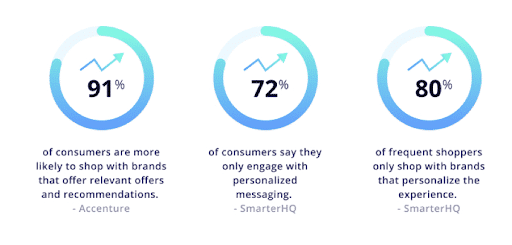
(Source)
Lisa Richards, CEO of The Candida Diet, is also a votary of improving your customer retention rate by using personalized offers as a way of rewarding your customers for their brand loyalty.
Richards shares her own experience,
“Personalizing your discounts and offers is a powerful way of connecting with your customers individually and showing them you understand and value them. Adopting this strategy has directly boosted our customer retention rate by 25% over the past year.
Experiment with a few different offers to see which one each customer segment is most receptive to. You can also analyze past behavior to understand the kind of offer most appealing to the customer.”
Here’s an example of how an e-commerce brand offers relevant product recommendations based on shopping habits, offering a personalized shopping experience.
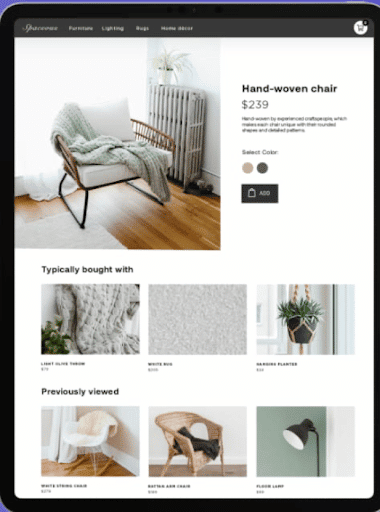
(Source)
Here are some more tips for personalizing your communication with customers:
- Use the customer’s first name when sending them an email or text message. This shows that you are paying attention and care about them as an individual. It also helps build rapport and trust between you and your customers.
- Use their name in your follow-up emails/phone calls/messages. This will help build rapport and trust between you and your customers by giving them the feeling that they are getting special treatment from you.
- Keep track of past purchases by adding details from previous purchases into new ones whenever possible. This allows you to make offers based on what they like, making them more likely to respond favorably to offers that appeal directly to their interests rather than generic ones that try to appeal to everyone at once (which rarely works).
- Personalize emails/text messages based on past purchases or website activity from each individual customer so they get offers relevant specifically to them instead of mass marketing tactics which rarely work well.
Pro Tip: Use specialized AI tools for the experimentation and analysis processes and craft highly targeted and personalized offers at scale. You can also employ AI tools to monitor how each offer is impacting your customer retention rate, allowing you to optimize your strategy fully.
4. Implement a Meaningful Referral Program
A referral program is one of the most effective ways to improve your customer retention rate. It’s a great way to get new customers, but it’s also an opportunity to strengthen relationships with existing ones.
The idea behind a referral program is simple: when someone purchases something from you, they get rewarded for sharing the information with others. In other words, they get paid for doing what they’d probably do anyway — tell their friends about their experience with your business.
Take Braxley Bands’ referral program, for instance:
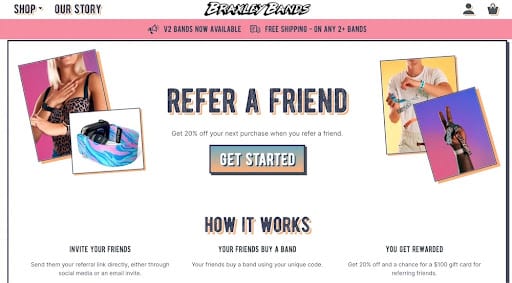
(Source)
There’s a 20% off the purchase when you refer a friend – for you and the friend.
Braxley Bands also introduced a small reward of a $100 gift card (that’s essentially three more bands for the advocate). All the advocate needs to do is spread the word.
Andrew Cussens, Owner & Director, FilmFolk, also suggests,
“Referral programs allow you to reward your customers, which makes them feel valued, making them opt to remain loyal to the company. Simultaneously, a robust referral program helps you acquire new customers.
Studies also show that customers gained through referrals are nearly 40% more likely to remain loyal to the brand. Hence, referral programs are an effective way of boosting your customer retention rates.”
5. Use Surveys to Collect Customer Feedback
Surveys are a great way to collect feedback from customers. They can tell you how satisfied your customers are with your products, services, and company as a whole.
There are many reasons why it’s important to gather this information.
One reason is that it will help you make decisions about your business based on what your customers want. For example, if you find out that most of your customers prefer one type of product over another, then you can decide whether to continue selling the product that’s not selling well or stop selling it together.
Another reason is that surveys can help you find out what improvements need to be made in order to keep customers happy and coming back for more. If they’re dissatisfied with something about your business — such as shipping times or customer service — then having the results from a survey can help you make the necessary changes so that they’ll continue doing business with you.
You can also use surveys to:
- Gather feedback about your products or services and how well they meet the needs of your customers.
- Learn about your customer’s experience with your company and employees.
- Identify areas where you need to improve, such as customer service or product quality.
- Create more personalized services for individual customers based on their needs and preferences.
For instance, Mack Weldon sends feedback emails to their shoppers after they make a purchase. The product they bought is front and center and has a click-to-rate widget.
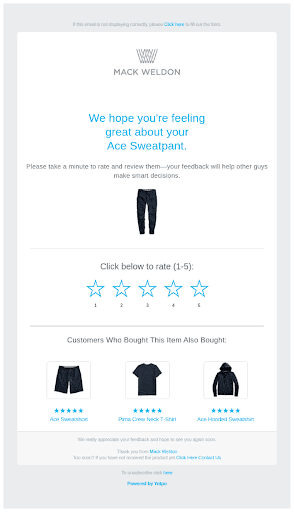
(Source)
You will also see a personalized product carousel closing off the email. There are other products other shoppers bought next to their star rating, encouraging you to make another purchase, especially if you are satisfied with their first purchase.
Karden Rabin, Co-Founder of CFS School, also suggests getting customer feedback to improve your operations.
Rabin suggests,
Yes, it’s helpful to know what’s working, but even more helpful to know what’s not working. Under 10% of customers write reviews, good or bad, and ideally, you want to learn how to improve without that criticism being made public.
Luckily, many people who take issue with a point of sale will tell you all about it if you make it easy for them. Sending follow-up emails asking for feedback takes the customer under a minute to share their thoughts.
The information you learn from these can mean not making the same mistake twice and risk losing customer loyalty in the future. Bonus points go to companies that can respond to feedback that reflects positively on the company and thus build trust with customers.
6. Use Cohort Analysis to Understand Consumer Behaviors
One way to improve your customer retention rate is through cohort analysis, which looks at the behavior of groups of customers over time. Cohort analysis helps you identify what factors contribute to customer retention and how to apply those findings in your business.
Why is Cohort Analysis Important?
When you want to understand why some customers are leaving you, the first step is determining what happened in their lives that caused them to leave. If you can identify the specific events (e.g., a competitor offered a discount) and their impact on your business, then you can take action to prevent those same events from happening again.
For example, if you have an ecommerce website and notice that sales drop significantly during Black Friday weekend (a very busy week for retailers), then there must be something about that event that affects your business negatively. If you want your company to thrive in the long term, then you need to identify those factors and work on eliminating them from impacting your business’s success.
Sam Tabak, Board Member, RMBH Charities, also shares,
“Cohort analysis helps improve retention by giving your business a clear view of how consumers interact with your products. A significantly increased churn level can signify that customers are getting less value and the products are no longer meeting their needs as they once did. Moreover, scrutinizing the end-to-end customer experience should be the top priority to identify what’s causing the churn.
Customer attrition directly decreases revenue, so it is vital to keep it at bay and avoid it at all costs. With cohort analysis, you can further your course of action to boost customer retention rates and find correlations to the reasons for their churn.”
7. Provide a Better Onboarding Experience
The onboarding experience is what happens when a new customer first uses your product. It should be designed to help them get started with everything they need to know about how your product works and what they can do with it. A good onboarding experience will make it easy for users to get results immediately – so they feel confident using the product.
A poor onboarding experience can turn off customers before they even start using your product. Make sure that your onboarding experience is clear and simple so that users can easily learn how to use your product and achieve their goals.
For example, when setting up a shop in Esty, you can see a progress meter that tracks your progress and tells you how much work is left to do.

(Source)
Another good example is Airbnb. When users first click on the Signup button on the site, they get different signup options.
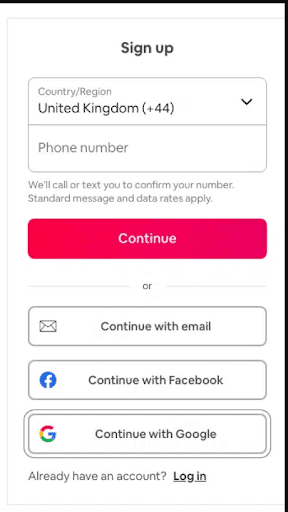
(Source)
After signing up, new users are asked to add additional details, such as their phone number. The company explains why they need this information, but users can skip the process if they want to get started right away.
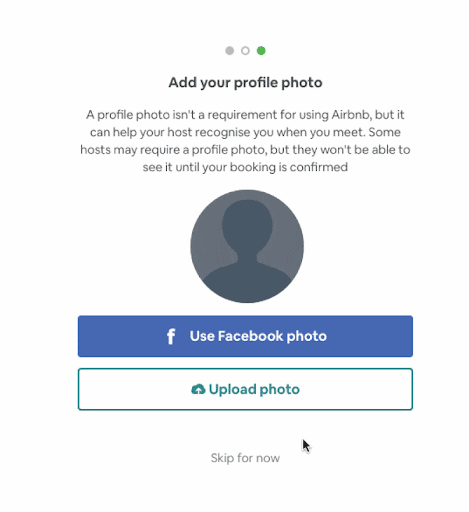
(Source)
When users click the Start Exploring’ button, they can easily find what they’re looking for.
8. Send Special Offers to Past Customers (But Don’t be Annoying)
Many businesses make the mistake of thinking that there’s no point in sending special offers to past customers. They think that because those customers have already bought from them, they already know who they are and what they’re about.
But the truth is, if you have a loyal customer base, then these customers are worth their weight in gold. They’re far more likely to buy from you again than new customers. And they’re also more likely to recommend your product or service to other people — which means more sales for you too.
Here are some tips for sending out special offers:
- Keep it simple – Don’t overwhelm people with too much information. You want them to take action, not get bogged down by details they don’t care about. Offer enough information that they understand what they’re getting into but no more than that.
- Be clear – Tell people exactly what they’re getting when they opt-in or purchase an item from your store. If there’s a limit on how many items can be purchased at once, say so clearly so nobody is surprised by having their order canceled after placing it because they exceeded their limit by one item.
- Don’t spam people – If someone opts in to receive emails from you or buys something from your store, don’t send them emails every day or week unless there is truly something important happening.
For example, Harney & Sons Fine Teas offers its existing customers a $10 discount code good on any purchase at its online store. It is a way to reward loyal customers without being intrusive.
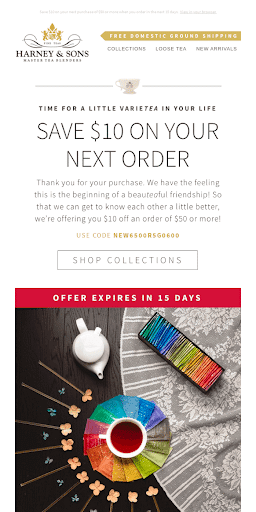
(Source)
9. Develop a Realistic Roadmap for the Customers
Ludovic Chung-Sao, Lead Engineer and Founder of Zen Soundproof and previously a Customer Retention Optimization professional at a telecom company in Taiwan believes that one of the most effective tips for retaining customers is to develop a realistic roadmap for them.
He suggests,
“Having a clear understanding of the product or service, as well as its goals and objectives, can make a world of difference in keeping your clients engaged. This includes having measurable steps that can be taken over a certain period to help ensure client satisfaction.
Developing this roadmap should consider the industry, budget range, size, and project timeline so you can customize it to an individual’s needs. Once this step is completed, you can take tangible steps toward improving customer retention rates.”
Wrapping Up
If you follow these customer retention strategies, you should have very little trouble improving your customer retention rate.
But, above all else, don’t get too tied down in specifics. Just focus on building customer relationships, exceeding customer expectations, and finding out what they need to keep them coming back in the future. That’s always been the basic when the goal is to retain customers, and it probably always will be.


